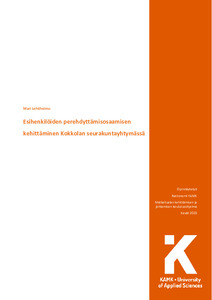Esihenkilöiden perehdyttämisosaamisen kehittäminen Kokkolan seurakuntayhtymässä
Lehtiheimo, Mari (2023)
Lehtiheimo, Mari
2023
All rights reserved. This publication is copyrighted. You may download, display and print it for Your own personal use. Commercial use is prohibited.
Julkaisun pysyvä osoite on
https://urn.fi/URN:NBN:fi:amk-202303033003
https://urn.fi/URN:NBN:fi:amk-202303033003
Tiivistelmä
Tämän opinnäytetyön toimeksiantajana toimi Kokkolan seurakuntayhtymä. Tutkimuksen tarkoituksena oli selvittää perehdyttämisen ongelmakohtia seurakuntayhtymässä esihenkilöiden ja työntekijöiden kokemusten kautta. Opinnäytetyön tavoitteena oli luoda esihenkilöiden perehdyttämisosaamiselle sekä perehdyttämisprosessille kehittämisehdotuksia, joiden kautta perehdyttämisestä saadaan tasalaatuista, tehokasta ja työhyvinvointia tukevaa.
Opinnäytetyön teoreettinen viitekehys koostuu perehdyttämisestä, esihenkilötyöstä ja siihen liittyen työnantajamielikuvasta, työntekijäkokemuksesta ja työhyvinvoinnista. Lisäksi osaamista, sen johtamista ja kehittämistä sekä hiljaista tietoa osana osaamista tarkastellaan omana osionaan.
Tutkimus toteutettiin tapaustutkimuksena eli case-tutkimuksena käyttäen sekä määrällistä että laadullista tutkimusotetta eli mixed methodia. Aineistoa kerättiin esihenkilöiltä ja työntekijöiltä Webpropol-kyselyillä, joissa oli sekä väittämiä että avokysymyksiä. Työntekijästä esihenkilön rooliin siirtyneitä haastateltiin teemahaastattelua käyttäen siitä, millaiset kokemukset heillä oli saamastaan perehdyttämisestä siirtyessään uuteen tehtäväänsä. Laajemman kokonaiskuvan saamiseksi myös havainnoitiin erilaisia perehdyttämistilanteita seurakuntayhtymässä kahden vuoden ajan, havainnointitilanteista pidettiin havaintopäiväkirjaa.
Tutkimus tuotti perehdyttämisen kehittämiseksi viisi osa-aluetta, joiden tarkemmissa sisällöissä on huomioitu sekä esihenkilöiden että työntekijöiden näkökulmia. Osa-alueita ovat: perehdytyssuunnitelma, perehdytysjakso, osallistaminen, koulutus ja yhteistyö. Kehittämisehdotukset viedään Kokkolan seurakuntayhtymän yhteistyötoimikuntaan ja operatiiviseen johtoryhmään, joissa valitaan ensisijaiset kehittämiskohteet, laaditaan kehittämissuunnitelma, -aikataulu sekä nimetään vastuuhenkilöt kehittämisprosessin eteenpäinviemiseen. Perehdyttämisen ollessa osa myös henkilöstön kehittämistä, hyödynnetään kehittämisideoita myös henkilöstöstrategian laatimisessa. This thesis was commissioned by the Kokkola Parish Union. The purpose of the study was to examine the problems of induction in the Parish Union through the experiences of supervisors and employees. The aim of the thesis was to create development proposals for the induction skills of the supervisors and the induction process in order to make the induction process consistent, effective and supportive of well-being at work.
The theoretical framework of the thesis consists of induction, management and related employer image, employee experience and well-being at work. In addition, knowledge, its management and development, and tacit knowledge as part of knowledge will be examined in a separate section
The study was carried out as a mixed-method case study using both quantitative and qualitative research method. Data was collected from supervisors and employees using Webpropol questionnaires with both statements and open-ended questions. The interviewees who had moved from the role of employee to that of supervisor were interviewed using thematic interviews about their experience of the induction training they had received when they moved into their new role. In order to get a broader picture, various induction situations in the Parish Union were also observed over a two-year period, and a diary of observations was kept.
The study produced five areas for developing induction, the more detailed content of which took into account the perspectives of both supervisors and employees. The components are: the induction plan, the induction period, participation, training and co-operation. The development proposals are taken to the Kokkola Parish Union’s co-operation committee and the operational management team, where priority areas for development are selected, a development plan and timetable are drawn up, and responsible persons are appointed to drive the development process forward. As induction is also part of staff development, the development ideas are also used in devising staff strategy.
Opinnäytetyön teoreettinen viitekehys koostuu perehdyttämisestä, esihenkilötyöstä ja siihen liittyen työnantajamielikuvasta, työntekijäkokemuksesta ja työhyvinvoinnista. Lisäksi osaamista, sen johtamista ja kehittämistä sekä hiljaista tietoa osana osaamista tarkastellaan omana osionaan.
Tutkimus toteutettiin tapaustutkimuksena eli case-tutkimuksena käyttäen sekä määrällistä että laadullista tutkimusotetta eli mixed methodia. Aineistoa kerättiin esihenkilöiltä ja työntekijöiltä Webpropol-kyselyillä, joissa oli sekä väittämiä että avokysymyksiä. Työntekijästä esihenkilön rooliin siirtyneitä haastateltiin teemahaastattelua käyttäen siitä, millaiset kokemukset heillä oli saamastaan perehdyttämisestä siirtyessään uuteen tehtäväänsä. Laajemman kokonaiskuvan saamiseksi myös havainnoitiin erilaisia perehdyttämistilanteita seurakuntayhtymässä kahden vuoden ajan, havainnointitilanteista pidettiin havaintopäiväkirjaa.
Tutkimus tuotti perehdyttämisen kehittämiseksi viisi osa-aluetta, joiden tarkemmissa sisällöissä on huomioitu sekä esihenkilöiden että työntekijöiden näkökulmia. Osa-alueita ovat: perehdytyssuunnitelma, perehdytysjakso, osallistaminen, koulutus ja yhteistyö. Kehittämisehdotukset viedään Kokkolan seurakuntayhtymän yhteistyötoimikuntaan ja operatiiviseen johtoryhmään, joissa valitaan ensisijaiset kehittämiskohteet, laaditaan kehittämissuunnitelma, -aikataulu sekä nimetään vastuuhenkilöt kehittämisprosessin eteenpäinviemiseen. Perehdyttämisen ollessa osa myös henkilöstön kehittämistä, hyödynnetään kehittämisideoita myös henkilöstöstrategian laatimisessa.
The theoretical framework of the thesis consists of induction, management and related employer image, employee experience and well-being at work. In addition, knowledge, its management and development, and tacit knowledge as part of knowledge will be examined in a separate section
The study was carried out as a mixed-method case study using both quantitative and qualitative research method. Data was collected from supervisors and employees using Webpropol questionnaires with both statements and open-ended questions. The interviewees who had moved from the role of employee to that of supervisor were interviewed using thematic interviews about their experience of the induction training they had received when they moved into their new role. In order to get a broader picture, various induction situations in the Parish Union were also observed over a two-year period, and a diary of observations was kept.
The study produced five areas for developing induction, the more detailed content of which took into account the perspectives of both supervisors and employees. The components are: the induction plan, the induction period, participation, training and co-operation. The development proposals are taken to the Kokkola Parish Union’s co-operation committee and the operational management team, where priority areas for development are selected, a development plan and timetable are drawn up, and responsible persons are appointed to drive the development process forward. As induction is also part of staff development, the development ideas are also used in devising staff strategy.
